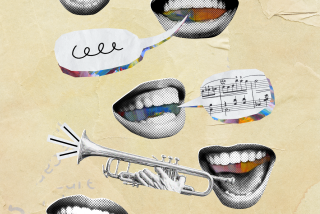Mask Maker Puts Authentic Face on Folkloric Dancing
Alfredo Calderonâs career has combined the two great loves of his life: mask making and folkloric dance.
Calderon, 32, is general director of Ballet Folklorico Cuicacalli, a Mexican dance group founded in 1974 during his student days at California State University, Northridge. He designs and makes all the masks the dancers wear, researches the costumes and music, choreographs the dances and even pinch hits for absent dancers during performances.
Working from a bright, airy studio in his Pacoima home, Calderon is surrounded by half-completed masks and clay tiles, carefully wrapped in plastic to prevent drying, waiting to be worked again. Pegboard-covered walls make it easy for him to hang completed masks.
Upstairs is a book collection that focuses on Latino and artistic themes. Throughout the house, his walls are decorated with masks from many cultures. His living room has become a studio, with work tables instead of sofas and chairs.
When Calderon sees a new mask, in a book or elsewhere, he imagines it as part of a folk dance, then researches the authentic, historical use of the mask.
âMasks are meant to be seen in motion,â he said.
Last year, with a fellowship from the Brody Art Fund, he spent six weeks in Mexico researching dances. One of his favorites, and a rarity in folkloric circles, is the Para Chicos dance from the state of Chiapas, where it is performed in only one small village.
This 18th-Century dance is based on the true story of a Chiapas woman whose sick child was carried through the streets on a litter. Villagers dressed up in what they imagined to be the costumes of porcelain dolls and danced alongside the boy in an attempt to cheer him up. The papier-mache masks have highly stylized doll faces with florid skin and a blond Chico Marx-type wig.
It was through Calderonâs research that Ballet Folklorico Cuicacalli acquired this dance, adding to their reputation for accuracy in folkloric interpretation. (Cuicacalli means house and school of dance in Nahautl, language of the Aztecs.)
Calderon has studied frescoes and figurines to come up with dances before the 17th Century that had not been documented previously.
âWe donât want people making up folklore out of the air,â he said.
The dancers have toured Europe as part of an international folk dance exposition and performed at the Craft and Folk Art Museumâs Festival of Masks and at the Southwest Museum. At the folk art museum, Calderon is known for his enthusiasm.
âAlfredo always does way above what is called for,â said Katie Bergin, who has been associate producing director for the museumâs festival of masks.
Many of Calderonâs masks are not meant to be worn. Among these are clay creations--fragile, intricate wall pieces that look too delicate to touch.
The masks of a Maya noblewoman and the Aztec god Quetzalcoatl, just back from a show at the Brooks Gallery in Santa Barbara, are displayed on his studio pegboard. These are âmythological interpretationsâ that Calderon sculpted after studying documents that preceded the conquest of Mexico by the Spaniards in 1519.
To finish the masks, he used a wide palette (turquoise, green, blood red, yellow) of vegetable dye watercolors, which produced a matte finish. He then used a mud wash to soften the colors and give them a just-unearthed patina.
Calderon, who was born in the state of Michoacan, Mexico, and moved to the San Fernando Valley as a child, said he hopes that his art will rekindle a flame in the Mexican-American community here.
âThe Hispanic identity is in limbo and through the visual and performing arts we can recapture it,â he said. He lamented both what he views as lack of interest in their cultural background by most Mexican Americans and a general lack of support for the arts in the San Fernando Valley.
âA lot of people here like to sit around and eat tacos and listen to Vicente Fernandez,â he said, referring to a popular Mexican singer, âand to them thatâs being Mexican. They arenât really interested in learning about the history and culture of Hispanics. We come from a society of astronomers and architects.â
He said Hispanics do not have to give up their old ways in order to acculturate. âWe can have our pie and eat it, too,â he said.
Through performances at local schools, Calderon hopes to reach an upcoming generation. As part of the Young Audience Program, which schedules assemblies for Los Angeles-area schools, the Ballet Folklorico Cuicacalli presents a âMasks of the Sunâ program that begins with the story of each dance and includes an explanation of mask making.
The program ends with a festive carnival dance from the Veracruz area, with dancers wearing 10-foot-high body puppets and dancing out into the audience.
âHis is one of our more outstanding programs,â said Laura Benedon, program director for the Young Audience Program. âThereâs a tremendous amount of information sandwiched in a very entertaining program.â
Calderonâs mask-making workshops at the Natural History Museum have been one of the museumâs best-received classes, according to the museum. He has organized the series into four specific areas: pre-classic (Olmec), classic (Maya), post-classic (Aztec) and post-Conquest.
In each four-hour session students make a clay mask. With Calderonâs slides and historical discourse, the students have just enough time to complete a mask that is ready to dry and be fired. He shows them how to add color at home. Some of them have turned out so well that Calderon is trying to arrange a special exhibit of student work from the classes.
âWeâve gotten wonderful masks from people who have no art background, people who say, âI canât draw a straight line,â â he said.
âThe participants in his workshops are wildly enthusiastic,â said Pat Abrams, adult education coordinator for the Natural History Museum. âThey go home happy because they have completed a mask so successfully.â
More to Read
The biggest entertainment stories
Get our big stories about Hollywood, film, television, music, arts, culture and more right in your inbox as soon as they publish.
You may occasionally receive promotional content from the Los Angeles Times.










